

Religion. Buddhism. Religion founded by the Buddha Buddhism (, ) is an Indian religion based on a series of original teachings attributed to Gautama Buddha.
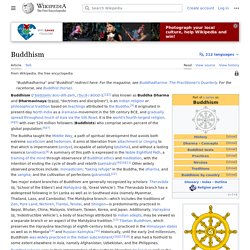
It originated in ancient India as a Sramana tradition sometime between the 6th and 4th centuries BCE, spreading through much of Asia. It is the world's fourth-largest religion[3] with over 520 million followers, or over 7% of the global population, known as Buddhists.[6] Buddhism encompasses a variety of traditions, beliefs and spiritual practices largely based on the Buddha's teachings (born Siddhārtha Gautama in the 5th or 4th century BCE) and resulting interpreted philosophies. Two major extant branches of Buddhism are generally recognized by scholars: Theravāda (Pali: "The School of the Elders") and Mahāyāna (Sanskrit: "The Great Vehicle"). Theravada has a widespread following in Sri Lanka and Southeast Asia such as Cambodia, Laos, Myanmar and Thailand.
Vinaya Pitaka. The Vinaya Piṭaka is a Buddhist scripture, one of the three parts that make up the Tripitaka.

Its primary subject matter is the monastic rules for monks and nuns. The name Vinaya Piṭaka (vinayapiṭaka) is the same in Pāli, Sanskrit and other dialects used by early Buddhists, and means basket of discipline. Date[edit] Vinaya Pitaka: The Basket of the Discipline. The Vinaya Pitaka, the first division of the Tipitaka, is the textual framework upon which the monastic community (Sangha) is built.
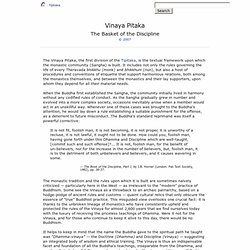
It includes not only the rules governing the life of every Theravada bhikkhu (monk) and bhikkhuni (nun), but also a host of procedures and conventions of etiquette that support harmonious relations, both among the monastics themselves, and between the monastics and their lay supporters, upon whom they depend for all their material needs. When the Buddha first established the Sangha, the community initially lived in harmony without any codified rules of conduct.
As the Sangha gradually grew in number and evolved into a more complex society, occasions inevitably arose when a member would act in an unskillful way. Whenever one of these cases was brought to the Buddha's attention, he would lay down a rule establishing a suitable punishment for the offense, as a deterrent to future misconduct. The Buddha's standard reprimand was itself a powerful corrective: Proto-Indo-European religion. Proto-Indo-European religion is the hypothesized religion of the Proto-Indo-European (PIE) peoples based on the existence of similarities among the deities, religious practices and mythologies of the Indo-European peoples.

Reconstruction of the hypotheses below is based on linguistic evidence using the comparative method. Archaeological evidence is difficult to match to any specific culture in the period of early Indo-European culture in the Chalcolithic.[1] Other approaches to Indo-European mythology are possible, most notably the trifunctional hypothesis of Georges Dumézil.[2] Pantheon[edit] Linguists are able to reconstruct the names of some deities in the Proto-Indo-European language (PIE) from many types of sources. Some of the proposed deity names are more readily accepted among scholars than others.[3] Pandemonium[edit] Mythology[edit] Dragon or Serpent[edit] Catholic Church - Wikipedia. Catholic social teaching emphasises support for the sick, the poor and the afflicted through the corporal works of mercy.
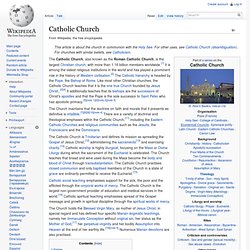
The Catholic Church is the largest non-government provider of education and medical services in the world.[16] Catholic spiritual teaching emphasises spread of the Gospel message and growth in spiritual discipline through the spiritual works of mercy. The Church holds the Blessed Virgin Mary, as mother of Jesus Christ, in special regard and has defined four specific Marian dogmatic teachings, namely her Immaculate Conception without original sin, her status as the Mother of God,[17] her perpetual virginity and her bodily Assumption into Heaven at the end of her earthly life.[18][note 5] Numerous Marian devotions are also practised.
Name[edit] Vegetation deity. In mythography of the 19th and early 20th century, as for example in The Golden Bough of J.G.
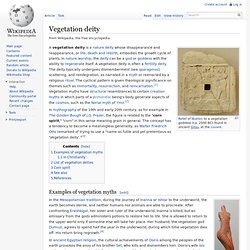
Frazer, the figure is related to the "corn spirit," "corn" in this sense meaning grain in general. The concept has a tendency to become a meaningless generality, as Walter Friedrich Otto remarked of trying to use a "name as futile and yet pretentious as 'Vegetation deity'. "[3] Examples of vegetation myths[edit] Cucuteni-Trypillian figurine with a sown field pattern. The Golden Bough. The Golden Bough: A Study in Comparative Religion (retitled The Golden Bough: A Study in Magic and Religion in its second edition) is a wide-ranging, comparative study of mythology and religion, written by the Scottish anthropologist Sir James George Frazer (1854–1941).
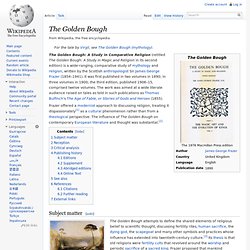
It was first published in two volumes in 1890; in three volumes in 1900; the third edition, published 1906–15, comprised twelve volumes. The work was aimed at a wide literate audience raised on tales as told in such publications as Thomas Bulfinch's The Age of Fable, or Stories of Gods and Heroes (1855). Frazer offered a modernist approach to discussing religion, treating it dispassionately[1] as a cultural phenomenon rather than from a theological perspective.
From Ritual to Romance - Jessie Laidlay Weston. BBC Radio 4 - In Our Time, The Fisher King. Fisher King. Confusingly, many works have two wounded Grail Kings who live in the same castle, a father and son (or grandfather and grandson).
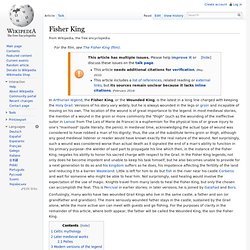
The more seriously wounded father stays in the castle, sustained by the Grail alone, while the more active son can meet with guests and go fishing. For the purposes of clarity in the remainder of this article, where both appear, the father will be called the Wounded King, the son the Fisher King. Celtic mythology[edit] The Fisher King appears first in Chrétien de Troyes' Perceval (late 12th-century), but the character's roots may lie in Celtic mythology. Art. Mona Lisa. The Mona Lisa (Monna Lisa or La Gioconda in Italian; La Joconde in French) is a half-length portrait of a woman by the Italian artist Leonardo da Vinci, which has been acclaimed as "the best known, the most visited, the most written about, the most sung about, the most parodied work of art in the world".[1] The painting, thought to be a portrait of Lisa Gherardini, the wife of Francesco del Giocondo, is in oil on a white Lombardy poplar panel, and is believed to have been painted between 1503 and 1506, although Leonardo may have continued working on it as late as 1517.
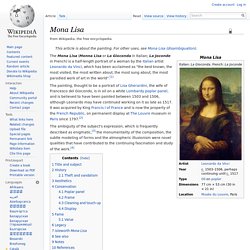
Virgin of the Rocks. The Virgin of the Rocks (sometimes the Madonna of the Rocks) is the name used for two paintings by Leonardo da Vinci, of the same subject, and of a composition which is identical except for several significant details.
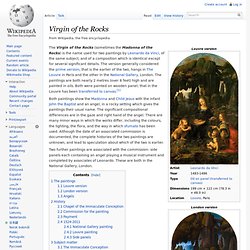
The version generally considered the prime version, that is the earlier of the two, hangs in The Louvre in Paris and the other in the National Gallery, London. The paintings are both nearly 2 metres (over 6 feet) high and are painted in oils. Both were painted on wooden panel; that in the Louvre has been transferred to canvas.[1] Both paintings show the Madonna and Child Jesus with the infant John the Baptist and an angel, in a rocky setting which gives the paintings their usual name. The significant compositional differences are in the gaze and right hand of the angel. Two further paintings are associated with the commission: side panels each containing an angel playing a musical instrument and completed by associates of Leonardo. Walter Pater - Mona Lisa.
The Decay of Lying. Wilde presents the essay in a Socratic dialogue, with the characters of Vivian and Cyril having a conversation throughout. The conversation, although playful and whimsical, promotes Wilde's view of Romanticism over Realism.[1] Vivian tells Cyril of an article he has been writing called "The Decay Of Lying: A Protest". In the article Vivian defends Aestheticism and "Art for Art's sake". As summarized by Vivian, it contains four doctrines: Art never expresses anything but itselfAll bad art comes from returning to Life and Nature, and elevating them into idealsLife imitates Art far more than Art imitates LifeLying, the telling of beautiful untrue things, is the proper aim of Art The essay ends with the two characters going outside, as Cyril asked Vivian to do at the beginning of the essay.
References[edit] Wilde, Oscar. External links[edit] Classics. Carthage. Downfall of the Carthaginian Empire Lost to Rome in the First Punic War (264BC – 241BC) Philomela. The Rape of Philomela by Tereus, engraved by Virgil Solis for a 1562 edition of Ovid's Metamorphoses (Book VI, 519-562). Philomela or Philomel (Ancient Greek: Φιλομήλα) is a minor figure in Greek mythology and is frequently invoked as a direct and figurative symbol in literary, artistic, and musical works in the Western canon. She is identified as being the "princess of Athens" and the younger of two daughters of Pandion I, King of Athens and Zeuxippe. Her sister, Procne, was the wife of King Tereus of Thrace. While the myth has several variations, the general depiction is that Philomela, after being raped and mutilated by her sister's husband, Tereus, obtains her revenge and is transformed into a nightingale (Luscinia megarhynchos), a migratory passerine bird native to Europe and southwest Asia noted for its song.
Philomela in the Waste Land. Cymbeline. Imogen in her bed-chamber where Iachimo witnesses the mole under her breast. Illustrated by Wilhelm Ferdinand Souchon in 1872 Cymbeline /ˈsɪmbɨliːn/, also known as Cymbeline, King of Britain or The Tragedy of Cymbeline, is a play by William Shakespeare, set in Ancient Britain (part of the play is set in the area corresponding to Wales[1]) and based on legends concerning the early Celtic British King Cunobeline. Although listed as a tragedy in the First Folio, modern critics often classify Cymbeline as a romance.
Antony and Cleopatra. Many consider the role of Cleopatra in this play one of the most complex female roles in Shakespeare's body of work.[3]:p.45 She is frequently vain and histrionic, provoking an audience almost to scorn; at the same time, Shakespeare's efforts invest both her and Antony with tragic grandeur. These contradictory features have led to famously divided critical responses.[4] Characters[edit] Synopsis[edit] Cleopatra. Cleopatra VII Philopator (Greek: Κλεοπάτρα Φιλοπάτωρ; Late 69 BC[1] – August 12, 30 BC), known to history as Cleopatra, was the last active pharaoh of Ancient Egypt, only shortly survived by her son, Caesarion as pharaoh. BBC Radio 4 - In Our Time, Cleopatra. Tiresias. Tiresias strikes two snakes with a stick, and is transformed into a woman by Hera. Engraving from Die Verwandlungen des Ovidii (The Metamorphoses of Ovid) by Johann Ulrich Kraus, c. 1690 Tiresias was a prophet of Apollo.
Overview[edit] Eighteen allusions to mythic Tiresias, noted by Luc Brisson,[2] fall into three groups: one, in two episodes, recounts Tiresias' sex-change and his encounter with Zeus and Hera; a second group recounts his blinding by Athena; a third, all but lost, seems to have recounted the misadventures of Tiresias. Tiresias within The Waste Land and “The Story of Tiresias” “The Story of Tiresias” from Ovid’s Metamorphoses lends a significant bit of background information to our understanding of Eliot’s The Waste Land. Cumaean Sibyl.
The Cumaean Sibyl is one of the four sibyls painted by Raphael at Santa Maria della Pace (see gallery below.) She was also painted by Andrea del Castagno (Uffizi Gallery, illustration right), and in the Sistine Ceiling of Michelangelo her powerful presence overshadows every other sibyl, even her younger and more beautiful sisters, such as the Delphic Sibyl. Sibyl/s. The Sibyls were oracular women believed to possess prophetic powers in ancient Greece, The earliest Sibyls, ‘who admittedly are known only through legend,’[1] prophesied at certain holy sites, under the divine influence of a deity, originally—at Delphi and Pessinos—one of the chthonic deities.
Modernity. (1) Radio, Archaeology, Literature: In Conversation with Tom McCarthy. World War I - Wikipedia. World War I (WWI or WW1), also known as the First World War, or the Great War, was a global war centred in Europe that began on 28 July 1914 and lasted until 11 November 1918. (1) "Beckett's Absent Paris: Malone Dies, Céline, and the Modernist City" Download (.pdf)Katz-Beckett-Celine.pdf1.62 MB. Literature. The rags of time john donne. SCENE II. The island. Before PROSPERO'S cell. Les Fleurs du mal. The first edition of Les Fleurs du mal with author's notes. Overview[edit] Au Lecteur (To the Reader. Au Lecteur La sottise, l'erreur, le péché, la lésine, Occupent nos esprits et travaillent nos corps, Et nous alimentons nos aimables remords, Comme les mendiants nourrissent leur vermine.
Nos péchés sont têtus, nos repentirs sont lâches; Nous nous faisons payer grassement nos aveux, Et nous rentrons gaiement dans le chemin bourbeux, Croyant par de vils pleurs laver toutes nos taches. Sur l'oreiller du mal c'est Satan Trismégiste Qui berce longuement notre esprit enchanté, Et le riche métal de notre volonté Est tout vaporisé par ce savant chimiste.
C'est le Diable qui tient les fils qui nous remuent! Bénédiction (Benediction. Bénédiction Lorsque, par un décret des puissances suprêmes, Le Poète apparaît en ce monde ennuyé, Sa mère épouvantée et pleine de blasphèmes Crispe ses poings vers Dieu, qui la prend en pitié: — «Ah! Woman is man's ruin canterbury tales. Prince Hamlet - Wikipedia. Tristan und Isolde. Alms for Oblivion: Tristan & The Wasteland: A Foot-Note. Tristan and Iseult. Inferno (Dante) BBC Radio 4 - In Our Time, Dante's Inferno. Allusions to Dante's Inferno in T.S. Eliot's The Waste Land. The Western Canon: The Books and School of the Ages.